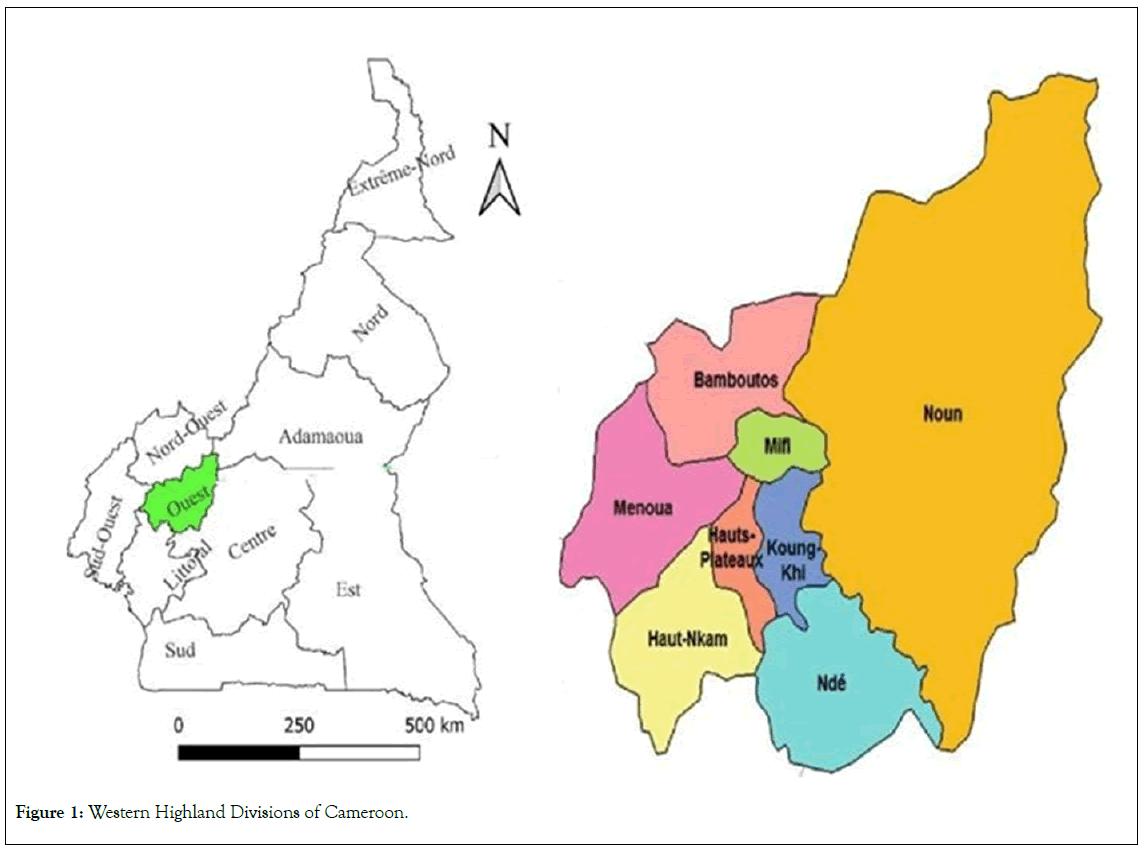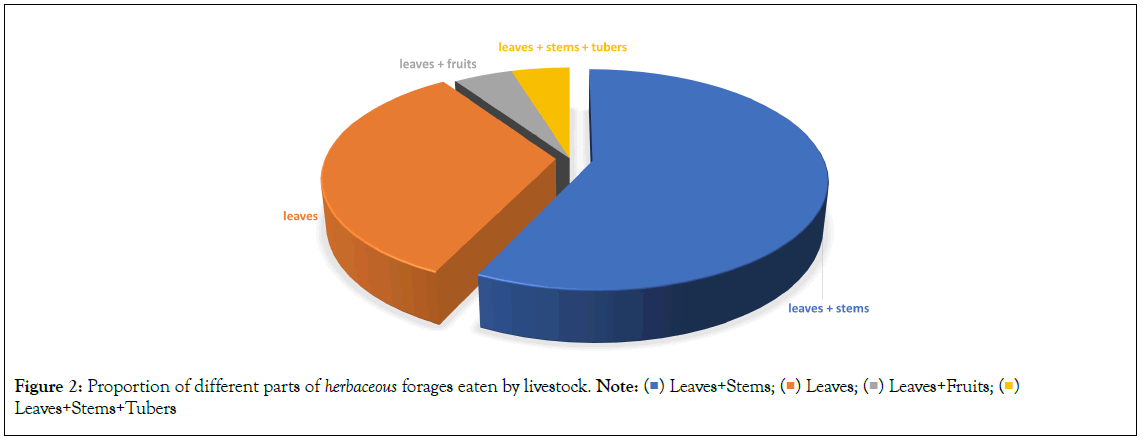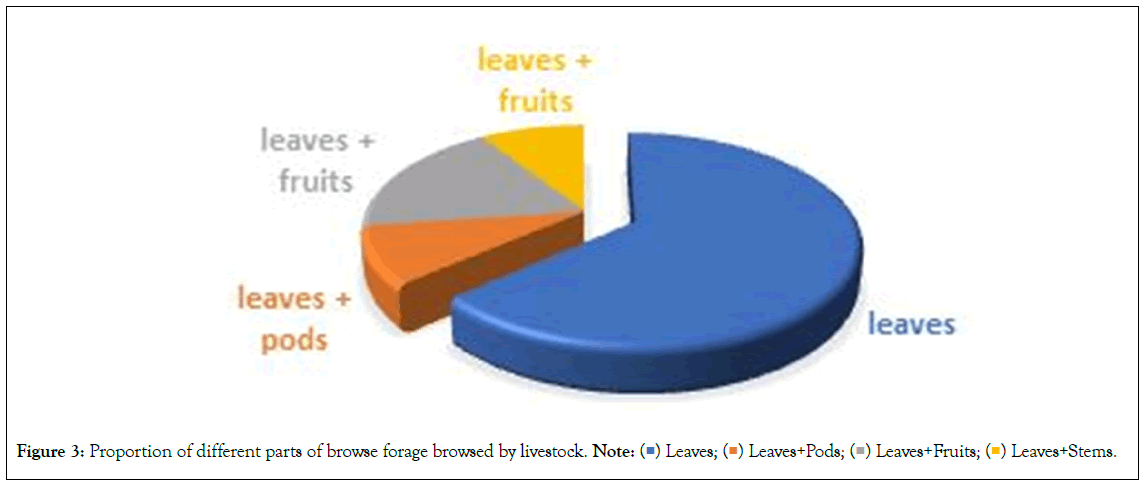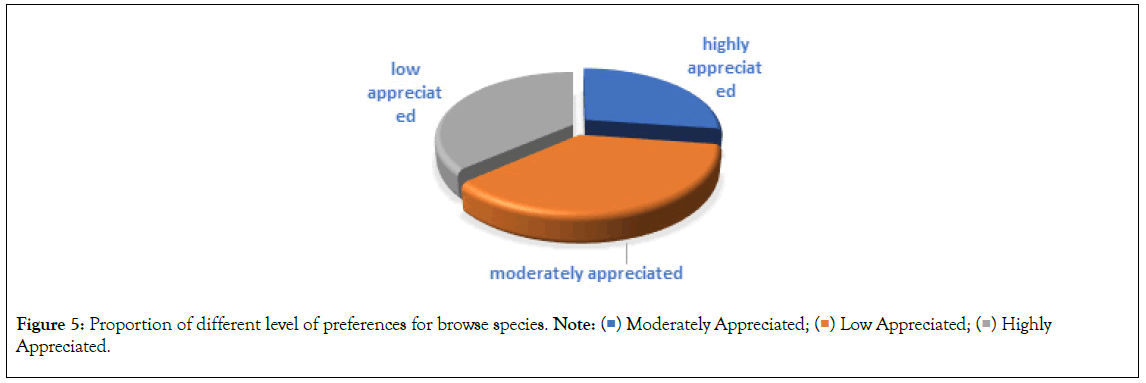Indexed In
- Open J Gate
- Genamics JournalSeek
- Academic Keys
- ResearchBible
- Cosmos IF
- Access to Global Online Research in Agriculture (AGORA)
- Electronic Journals Library
- RefSeek
- Directory of Research Journal Indexing (DRJI)
- Hamdard University
- EBSCO A-Z
- OCLC- WorldCat
- Scholarsteer
- SWB online catalog
- Virtual Library of Biology (vifabio)
- Publons
- Geneva Foundation for Medical Education and Research
- Euro Pub
- Google Scholar
Useful Links
Share This Page
Journal Flyer

Open Access Journals
- Agri and Aquaculture
- Biochemistry
- Bioinformatics & Systems Biology
- Business & Management
- Chemistry
- Clinical Sciences
- Engineering
- Food & Nutrition
- General Science
- Genetics & Molecular Biology
- Immunology & Microbiology
- Medical Sciences
- Neuroscience & Psychology
- Nursing & Health Care
- Pharmaceutical Sciences
Research Article - (2023) Volume 12, Issue 4
Qualitative Assessment of Fodder Species in the Western Highlands of Cameroon
Leslie Tieubou Tsopgni1*, Jules Lemoufouet1, Adrian Nazare2, Bogdan Isac2, Costel Samuil2 and Vasile Vintu22Department of Plant Sciences, University of Life Sciences Ion Ionescu De La Brad of Iasi, Iasi, Romania
Received: 01-May-2023, Manuscript No. AGT-23-21991; Editor assigned: 04-May-2023, Pre QC No. AGT-23-21991 (PQ); Reviewed: 18-May-2023, QC No. AGT-23-21991; Revised: 25-May-2023, Manuscript No. AGT-23-21991 (R); Published: 01-Jun-2023, DOI: 10.35248/2168-9881.23.12.329
Abstract
The identification of fodder species present in any locality is crucial for ensuring better management of pastures. Studies on forage plant inventories and livestock preferences are very limited in Western Highlands of Cameroon (WHC). Hence, the aim of this study was to identify local forage plants and assess livestock preferences in WHC. A survey was carried out involving 50 breeders with at least two years of experience in the livestock sector to acquire information on the type of forage resources consumed by livestock and their preferences. The results showed that 32 forage species were present in WHC, with 21 herbaceous and 11 browse forages. The most widely consumed parts of these plants are the leaves. The species most appreciated by livestock are in low proportion compared to the average ones, leading to a gradual deterioration in the quality of pastures. Measures must be taken to ensure the conservation of forage appreciated by livestock by delimiting and extending the areas of grazing land in the WHC.
Keywords
Fodder species; Forage; Livestock; Preferences
Introduction
Identifying the local fodder species through studies is a key step to improve pasture management. [1]. Especially as these have already developed qualities and adaptations over time that are perfectly suited to the environmental conditions of the area [2]. Studies have been carried out by and in Cameroon, Ghana, Benin, Algeria and Ethiopia, to identify local forage plants in these different localities [3-7]. The identification and characterization of forage are imperative because the zoo technical performance of livestock is strongly linked to the quality of pastures [8]. Pahimi, et al., listed approximately 41 species in North Cameroon, of which Prosopis africana, Daniella oliveri, Acacia sieberiana, Stereospermum kunthianum, and Balanites aegyptica were the most appreciated by livestock [4]. They also observed that many of these species are in decline, such as Prosopis africana, Daniella oliveri, and Polygonum acuminatum, owing to the shrinking of grazing areas in favor of croplands. Lucha, et al., listed 151 forage species in the savannahs of the Ngoketunjia division in Northwest Cameroon [3]. The most abundant species were Desmodium ascendens, Urena lobeta, Bracharia lata, and Vitex doniana. However, few of these are appreciated by livestock because some grazers complain that fire is a major threat to forage plants. This destroys some plant species and leads to species extinction. Neba Ndenecho Emmanuel Recommended the utilization of plants of the Moraceae family in this zone, particularly Ficus spp., which are readily browsed by ruminants and fire resistant [9]. However, no studies have been conducted from this perspective in the Western Highlands of Cameroon (WHC). Hence, the aim of this study is therefore to contribute to a better appreciation of the floristic diversity of forages by identify local forage plants and assess livestock preferences in WHC.
Materials and Methods
Description of the study area
The Western Highlands of Cameroon is characterized by a rainfall of 1500 mm-2000 mm with a 9-month rainy season and 3-month dry season. The average annual temperature ranges from 22°C to 25°C. The soils are ferralitic, sandy-clay, generally not deep, and rejuvenated by erosion. Rich in humus, they are suitable for food and perennial crops.
Sampling
Five divisions in which ruminant breeders had a large herd with at least two years’ experience were chosen, namely, Menoua, Bamboutos, Ndé, Mifi, and Noun (Figure 1). On the same basis, three districts were chosen per division. In these three districts, the snowball sampling or chain sampling method consisting of identifying new breeders from other breeders to form part of the sample was used. A total of fifty breeders were asked to provide information on the forage species consumed by their livestock and their preferences. Subsequently, with their permission, direct observation on the field was carried out to identify the forage species.

Figure 1: Western Highland Divisions of Cameroon.
Forage species identification
Forage species were identified using the botanical guides “Graminée du Cameroun” and “Guide des ligneux” [10,11]. The identification of fodder plants was based on their morphological characteristics, according to these guides.
Results and Discussions
Local forages identified
In the Western Highlands of Cameroon, 32 forage species are consumed by livestock (Table 1). Of these, 21 species are herbaceous plants and belonging to 6 families: Poaceae (11 species), Fabaceae (5 species), Convolvulaceae (2 species), one species each of Malvaceae, Musaceae and Solanaceae. On the other hand, 11 species are browse plants belonging to 7 families: Fabaceae (4 species), Asteraceae (2 species), one species of Asparagaceae, Lauraceae, Myrtaceae, Euphorbiaceae and Meliaceae.
| Herbaceous | Families | Species | Herbaceous | Families | Species |
| Poaceae | Bracharia ruziziensis | Convolvulaceae | Ipomea batatas | ||
| Poaceae | Cynodon dactylon | Convolvulaceae | Dichondra micrantha | ||
| Poaceae | Panicum maximun | Malvaceae | Sida acuta | ||
| Poaceae | Digiatria ciliaris | Musaceae | Musa paradisiaca | ||
| Poaceae | Pennisetum purpereum | Solanaceae | Browallia americana | ||
| Poaceae | Pennisetum clandestinum | Fabaceae | Calliandra calothyrsus | ||
| Poaceae | Trypsacum laxum | Fabaceae | Leucena leucocephola | ||
| Poaceae | Imperata cylindrica | Fabaceae | Gliricidia sepium | ||
| Poaceae | Melinis repens | Fabaceae | Piliostigma thonningii | ||
| Poaceae | Setaria barbata | Lauraceae | Persea america | ||
| Poaceae | Urochloa panicoides | Myrtaceae | Psidium guajava | ||
| Fabaceae | Desmodium uncinatum | Euphorbiaceae | Manihot esculenta | ||
| Fabaceae | Desmodium intortum | Asparagaceae | Draceana fragrans | ||
| Fabaceae | Arachis glabrata | Asteraceae | Thitonia diversifolia | ||
| Fabaceae | Centrosema pubescens | Asteraceae | Vernonia amygdalina | ||
| Fabaceae | Trifolium hybridum | Meliaceae | Entandrophragma cylindricum |
Table 1: Herbaceous and browse forages consumed by livestock.
Interviews conducted by Pahimi, et al., with ruminant farmers in north Cameroon identified 14 herbaceous species, which were fewer than those listed in the WHC. Nevertheless, they observed a decline in the floristic diversity of fodder resources due to climate change, shrinking grazing areas, and bush fires. In contrast, 11 browsed species were also recorded. Pahimi, et al., recorded 31 browse species, which is similar to the results obtained by Ziblim, et al., in Ghana, who recorded 32 browse species. However, these values are lower than those obtained by Nachibingu, et al., in Congo and Denbela, et al., in Ethiopia, which recorded 43 and 50 browse species, respectively [1,4,5,7]. These differences between localities could be due to the fact that the floristic composition of an area’s vegetation is strongly linked to its climate, edaphic factors (soil type, depth, texture, humidity) and degree of anthropisation [12]. Most herbaceous species consumed by livestock belong to the Poaceae family, whereas browse species belong to the Fabaceae family. This is in line with Pahimi, et al., Lucha, et al., and Ziblim, et al., who listed 57%, 31% and 48.8% respectively of the herbaceous species consumed by cattle as belonging to the Poaceae family. Klein, et al., stated that in tropical Africa the majority of species consumed by cattle belong mainly to two families, namely Poaceae and Fabaceae.
Livestock preferences in Western Highlands of Cameroon
The most appreciated species and their parts eaten by livestock for herbaceous and browse species, as declared by breeders, are presented in Table 2.
| Herbaceous | Species | Parts of Plant Eaten | Preferences |
| Bracharia ruziziensis | Leaves + stems | *** | |
| Cynodon dactylon | Leaves + stems | ** | |
| Panicum maximun | Leaves + stems | ** | |
| Digiatria ciliaris | Leaves + stems | *** | |
| Pennisetum purpereum | Leaves + stems | *** | |
| Pennisetum clandestinum | Leaves + stems | *** | |
| Trypsacum laxum | Leaves | ** | |
| Imperata cylindrica | Leaves | * | |
| Melinis repens | Leaves | ** | |
| Setaria barbata | Feuilles + tiges | ** | |
| Urochloa panicoides | Leaves + stems | ** | |
| Desmodium uncinatum | Leaves + stems | ** | |
| Desmodium intortum | Leaves + stems | ** | |
| Arachis glabrata | Leaves | ** | |
| Centrosema pubescens | Leaves + stems | ** | |
| Trifolium hybridum | Leaves + stems | *** | |
| Ipomea batatas | Leaves + stems + tubers | ** | |
| Dichondra micrantha | Leaves + stems | ** | |
| Sida acuta | Leaves + stems | ** | |
| Musa paradisiaca | Feuilles + fruits | *** | |
| Browallia americana | Leaves | ** | |
| browse | Calliandra calothyrsus | leaves | *** |
| Leucena leucocephola | leaves | ** | |
| Gliricidia sepium | leaves | ** | |
| Piliostigma thonningii | leaves + pods | *** | |
| Persea america | leaves + fruits | ** | |
| Psidium guajava | leaves + fruits | ** | |
| Manihot esculenta | leaves + tubers | *** | |
| Draceana fragrans | leaves | * | |
| Thitonia diversifolia | leaves | * | |
| Vernonia amygdalina | leaves | * | |
| Entandrophragma cylindricum | leaves | * |
Note: *: Low appreciated, **: Moderately appreciated, ***: Highly appreciated.
Table 2: Parts of plant eaten by livestock and their preferences.
The most commonly consumed herbaceous species in WHC are Bracharia ruziziensis, Digiatria ciliaris, Pennisetum purpereum and Pennisetum clandestinum. This result is similar to those obtained by Babatounde, et al., who state that Pennisetum purpereum, Pannicum maximun and Bracharia ruziziensis are most appreciated by sheep in Benin [13]. On the other hand, Nachibingu, et al., note that Pennisetum purpureum (2.8%) and Sida acuta (2.5%) are among the species least consumed and the most consumed is Setaria pallide Fusca by livestock in the Kumbungu district of Ghana [5]. Calliandra calothyrsus, Piliostigma thonningii and Manihot esculenta are the most commonly consumed browse species in WHC. In North Cameroon, Ziblim, et al., found that Prosopis africana, Daniella oliveri, Acacia sieberiana, Stereospermum kunthianum and Balanites aegyptica were the browse species most appreciated by livestock. This shows that livestock preferences vary from one area to another. This could be explained by the fact that preferences depend on livestock feeding habits and the availability of these forage species in these different localities [4]. Klein, et., also state that the palatability of grasses for livestock is explained by the relatively soft texture of their tissues, their discreet taste and odor not marked by unpleasant or repellent substances, the absence or low content of toxic substances or tannins, the high content of digestible carbohydrates (celluloses, soluble sugars, etc.) and fats [14]. For herbaceous species, leaves+stems (57.14%) were the most frequently consumed parts, followed by leaves only (33.33%), leaves+stems+tubers (4.76%), and leaves+fruits (4.76%) (Figure 2). For browse species, the majority consumed leaves only (63.63%), followed by leaves+fruits (18.18%), leaves+tubers (9.09%), and leaves+pods (9.09%) (Figure 3).
Figure 2: Proportion of different parts of herbaceous forages eaten by livestock. Note: ( ) Leaves+Stems; (
) Leaves+Stems; ( ) Leaves; (
) Leaves; ( ) Leaves+Fruits; (
) Leaves+Fruits; ( ) Leaves+Stems+Tubers
) Leaves+Stems+Tubers
Figure 3: Proportion of different parts of browse forage browsed by livestock. Note: ( ) Leaves; (
) Leaves; ( ) Leaves+Pods; (
) Leaves+Pods; ( ) Leaves+Fruits; (
) Leaves+Fruits; ( ) Leaves+Stems.
) Leaves+Stems.
It results that for Herbaceous and browse species, the plant parts most consumed by livestock are the leaves. This result is similar to those obtained by Lucha, et al., Ziblim, et al., and Suheel, et al., who stated that leaves are the most parts consumed by livestock [3,5,15]. Also, Denbela, et al., declared that cattle have a preference for leaves over other parts of the plant because they are easily accessible, highly palatable and very rich in nutrients [7]. Moussa, et al., mentioned that the choice of forage species organs by livestock depends on the animal species, the season, the phenological stage of the plant, and the availability and quality of the forage species [16]. As reported by Denbela, et al., livestock consume more leaves during the rainy season, seeds and pods at the start of the dry season, and stems and bark towards the end of the dry season [7]. Highly, moderately and low appreciated herbaceous species represent 33.33%, 61.90% and 4.76% respectively. Therefore, highly, moderately and low appreciated browse species represent 27.27%, 36.36% and 36.39% respectively (Figures 4 and 5).
Figure 4: Proportion of different level of preferences for herbaceous species. Note: ( ) Highly Appreciated; (
) Highly Appreciated; ( ) Moderately Appreciated; (
) Moderately Appreciated; ( ) Low Appreciated.
) Low Appreciated.
Figure 5: Proportion of different level of preferences for browse species. Note: ( ) Moderately Appreciated; (
) Moderately Appreciated; ( ) Low Appreciated; (
) Low Appreciated; ( ) Highly Appreciated.
) Highly Appreciated.
It can be seen that the proportion of highly appreciated species is relatively low compared to those moderately appreciated. The breeders explained that the land allocated for grazing in this area is very small and the number of breeders is constantly increasing as a result of the migration of refugees fleeing the country’s war zones. This situation leads to overgrazing and the growth of other types of plants is encouraged. Indeed, when some animals focus on consuming a certain category of plants, this encourages the growth of other species that could be moderate, low or no palatable. Moreover, if their consumption is uncontrolled, they could disappear over the years [2].
Conclusion
A total of 32 forage species consumed by livestock have been recorded. Most forage species belong to two families namely Poaceae and Fabaceae. The leaves are the main part of the plant consumed. The forage highly appreciated by livestock is constantly declining, and if nothing is done, they are doomed to disappear. Expanding grazing land and forage cultivation could ensure the sustainability of plants with good pastoral value.
References
- Nachibingu B, Elois C, Iragi K, Moïse M, Charles M, Pazo D, et al. Identification of some fodder species in pastures in groups of bugorhe, bushumba, irhambi and miti in Kabare territory, DR Congo. Global Scientific Journals. 2019;7(8):1475-1488.
- Djennane K. Identification and study of the nutritional value of spontaneous fodder species in the region of Doucen wilaya of Biskra (Doctoral dissertation, Mohamed Khider-Biskra University). 2016.
- Lucha C, Chuyong G. Ethnobotanical Survey of Fodder/Forage Plant Species in Range and FarmingSystems in the Savannahs of Ngoketunjia, Northwestern Cameroon. Int J Curr Res Biosci Plant Biol. 2016;3(6):50-72.
- Pahimi AL, Yamndou ST, Damba R, Djoumessi AD. Qualitative evaluation of fodder species present in the department of Bénoué (Northern Cameroon). Int J Biol Chem Sci. 2020;14(4):1381-1389.
- Ziblim AI, Abdul-Rasheed S, Aikins TK. Forage species used by livestock in the kumbungu district of the northern region, Ghana. Int J Dev. 2015;1(1):18-29.
- Sewade C, Azihou AF, Fandohan AB, Houehanou TD, Houinato M. Diversity, pastoral and conservation priorities of fodder trees in the Sudano-Guinean pasture lands of Benin. Biotechnol Agron Soc Environ. 2016;20(2):113-29.
- Hidosa D, Hailu S, O’Reagain J. Goat Feed Inventory and Feed Balance in Hamer and Bena-Tsemay Woreda of South Omo Zone, South Western Ethiopia. Acta Sci Vet Sci. 2020;2(6):28-43.
- Ko Awono PD, Njehoya C, Akoa EM. Characteristics of pastures in northern Cameroon. Meetings around research on ruminants. 2012.
- Neba NE. Indigenous trees and shrubs in silvopastoral systems of the Bamenda highlands of Cameroon. Glob J Hum. Soc Sci. 2010;10(3):56-64.
- Van Der Zon A. Cameroon Grass Volume 1. Wageningen Agricultural University Papers. 1992.
- Geerling C. A field guide to Sahelian and Sudano‐Guinean woodlands. Agricultural University Wageningen. 1982.
- Essowazina Seou, Laounta Akame, Tchaa Boukpessi. Floristic diversity and structural characteristics of plant groups in the Zio basin (South-Togo). Physio-Géo. 2022;17(1): 83-98.
- Klein HD, Rippstein G, Huguenin J, Toutain B, Guerin H. Forage crops. Quae editions. 2014.
- Babatoundé S, Oumorou M, Tchabi VI, Lecomte T, Houinato M, Adandedjan C. Ingestion volontaire et préférences alimentaires chez des moutons Djallonké nourris avec des graminées et des légumineuses fourragères tropicales cultivées au Bénin. Int J Biol Chem Sci. 2010;4(4):1030-1043.
- Ahmad S, Singh JP, Verma DK. Inventory of important fodder plants of Ladakh Himalaya. 2015.
- Sani MM, Nassirou AM, Iro DG, Chapiou YG. Diversité et préférence des espèces fourragères par les animaux domestiques dans le centre-sud du Niger. 2020.
Citation: Tsopgni LT, Lemoufouet J, Nazare A, Isac B, Samuil C, Vintu V. (2023) Qualitative Assessment of Fodder Species in the Western Highlands of Cameroon. Agrotechnology. 12:329.
Copyright: © 2023 Tsopgni LT, et al. This is an open-access article distributed under the terms of the Creative Commons Attribution License, which permits unrestricted use, distribution, and reproduction in any medium, provided the original author and source are credited.






